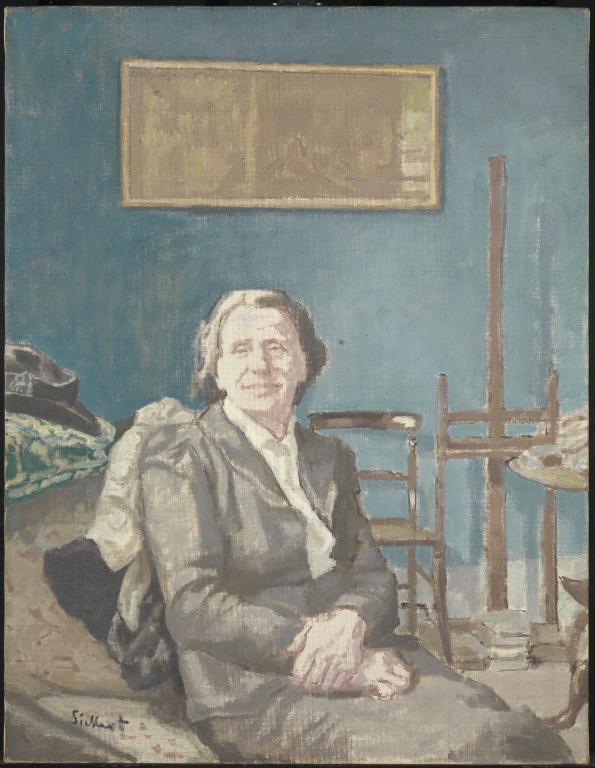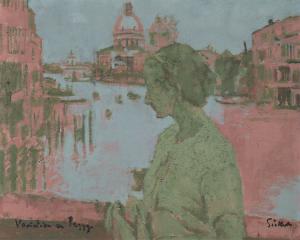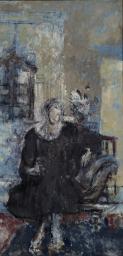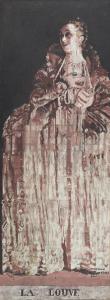Walter Richard Sickert Lady Martin 1935
Walter Richard Sickert,
Lady Martin
1935
Ada Martin is shown seated in the same deep blue drawing room of Sickert’s house at St-Peter’s-in-Thanet, near Broadstairs in Kent, as her husband Alec (Tate T00221). A clustered easel, chair and books piled on the floor in the background of the interior, along with the discarded hat and clothing strewn on the sofa against which Martin leans, contrast with the placidity of her figure and pale expression. Sickert used a camaieu preparation to achieve the visual effect of a slightly over-exposed photograph, and has left the white ground of the canvas exposed in places to describe areas of light. The work was the subject of a drawing by Frank Auerbach, Sketch from Sickert’s ‘Lady Martin’ c.1977–83 (Tate T07631).
Walter Richard Sickert 1860–1942
Lady Martin
1935
Oil paint on canvas
1397 x 1079 mm
Inscribed by the artist ‘Sickert’ in black paint bottom left
Presented by Sir Alec Martin, K.B.E., through the National Art Collections Fund 1958
T00222
1935
Oil paint on canvas
1397 x 1079 mm
Inscribed by the artist ‘Sickert’ in black paint bottom left
Presented by Sir Alec Martin, K.B.E., through the National Art Collections Fund 1958
T00222
Ownership history
Commissioned from the artist by Sir Alec Martin 1935, by whom presented through the National Art Collections Fund to Tate Gallery 1958.
Exhibition history
1981–2
Late Sickert: Paintings 1927 to 1942, (Arts Council tour), Hayward Gallery, London, November 1981–January 1982, Sainsbury Centre for the Visual Arts, University of East Anglia, Norwich, March–April 1982, Wolverhampton Art Gallery, April–May 1982 (24, reproduced).
1989–90
W.R. Sickert: Drawings and Paintings 1890–1942, Tate Gallery, Liverpool, March 1989–February 1990, Tate Gallery, London, July–September 1990 (39, reproduced).
References
1960
National Art Collections Fund Fifty-Sixth Annual Report 1959, London 1960, p.21.
1960
Lillian Browse, Sickert, London 1960, p.103.
1964
Mary Chamot, Dennis Farr and Martin Butlin, Tate Gallery Catalogues: The Modern British Paintings, Drawings and Sculpture, vol.2, London 1964, pp.639–40.
1967
David Sylvester, ‘Walter Sickert: More about the Englishness of English Art’, Artforum, vol.5, no.9, May 1967, p.45, reproduced p.44.
1973
Wendy Baron, Sickert, London and New York 1973, pp.174, 383.
1975
Richard Morphet, ‘The Modernity of Late Sickert’, Studio International, vol.190, no.976, July–August 1975, p.35.
1992
Wendy Baron and Richard Shone (eds.), Sickert: Paintings, exhibition catalogue, Royal Academy, London 1992, p.324.
2006
Wendy Baron, Sickert: Paintings and Drawings, New Haven and London 2006, no.720, pp.119, 538.
Technique and condition
Lady Martin is painted on a coarse open-weave cloth, which is probably jute. It has been sized and primed with a lean white primer, which extends to the cut edges and is stretched on a six-member wooden stretcher. The support was pre-primed and stretched by the artists’ colourmen Newman of Soho Square, whose distinctive circular stamp marks the back of the canvas in four places.
This portrait is very similar in its materials and techniques to the portrait of Sir Alec Martin (Tate T00221). The artist drew directly onto the prepared canvas with a brush in black paint to outline his image. It is not clear whether this initial drawing was executed from life, as was the portrait of Claude Phillip Martin (Tate T00223) initially. Again, like the other two Martin portraits, there is no evidence of any squaring-up on the preparatory surface, but there are traces of black lines that form a grid applied on top of the first painting. These probably relate to the use of a photograph on which the image is at least partly based, and which could have been squared-up for transfer and used with a ‘grille’ to facilitate the development of the tonal composition (see Tate T00221).
The artist adopted a technique developed from his camaieu preparation: the bright colours remain visible as the final image, except he selected two tones for each colour, one a pure pigment sometimes straight from the tube onto his palette, and the other the same pigment mixed with white on his palette. He has two browns for the chairs, two greens for the cushion, two grey/browns for the clothes, two red/pinks for the flesh and two blues for the background, which was applied last. The lights for each colour are the exposed white ground. The paint is all very lean oil applied by a brush with little mixing and working on the canvas. There is no modification to the composition and the painting appears to have been completed more quickly than the two other portraits, suggesting that Sickert had a very clear plan and may have curtailed his painting having achieved his minimal objective.
Stephen Hackney
November 2005
How to cite
Stephen Hackney, 'Technique and Condition', November 2005, in Nicola Moorby, ‘Lady Martin 1935 by Walter Richard Sickert’, catalogue entry, January 2006, in Helena Bonett, Ysanne Holt, Jennifer Mundy (eds.), The Camden Town Group in Context, Tate Research Publication, May 2012, https://wwwEntry
Ada Mary Fell married Alec Martin in 1909, and with her husband’s knighthood in 1934 she became Lady Martin. Walter Sickert painted her portrait in 1935 along with that of her husband and one of her sons (Tate T00221 and T00223, figs.1 and 2). He depicted her in the same room in Hauteville, his house in St-Peter’s-in-Thanet, in which he painted Sir Alec Martin. The walls are the same deep shade of blue and the same framed picture appears in both works. Ada Martin is shown seated on the edge of what is probably a chaise-longue. The room is in a state of some disarray. She is leaning against some clothes strewn on the back of her seat while behind her is a discarded black hat perched on top of some cushions. In the background against the wall stands a painting easel and small table and there is a pile of books on the floor. In contrast to the unconventional muddle of the interior, Martin herself appears calm and serene, with her hands folded in her lap and a slight, relaxed smile apparent on her face.
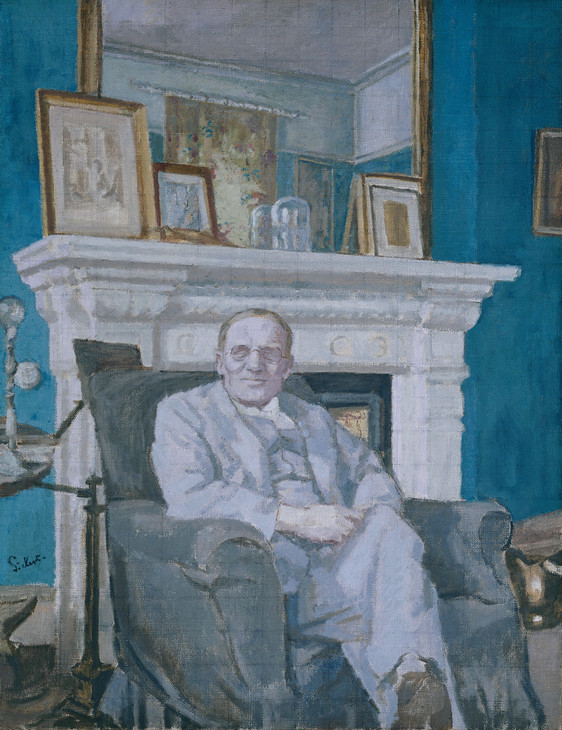
Walter Richard Sickert 1860–1942
Sir Alec Martin, KBE 1935
Oil paint on canvas
support: 1397 x 1079 mm
Tate T00221
Presented by Sir Alec Martin KBE through the Art Fund 1958
© Tate
Fig.1
Walter Richard Sickert
Sir Alec Martin, KBE 1935
Tate T00221
© Tate
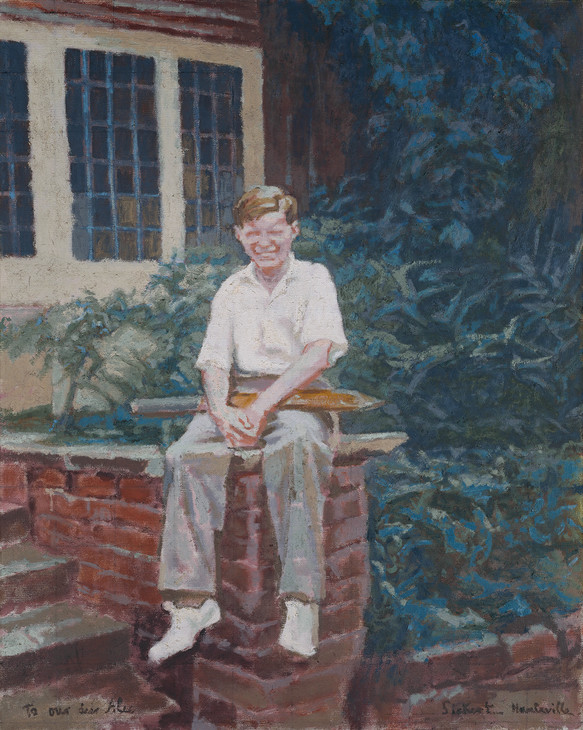
Walter Richard Sickert 1860–1942
Claude Phillip Martin 1935
Oil paint on canvas
support: 1270 x 1016 mm
Tate T00223
Presented by Sir Alec Martin KBE through the Art Fund 1958
© Tate
Fig.2
Walter Richard Sickert
Claude Phillip Martin 1935
Tate T00223
© Tate
Martin told her husband that she remembered Sickert’s wife, Thérèse Lessore, unexpectedly taking a photograph of her one day as she entered the room.1 Although it seems unlikely that the composition of the portrait was based entirely upon that snapshot, it nevertheless seems reasonable to suppose that the painting was at least partially based upon the photographic record. Sickert particularly liked using photographs to define the tonal passages of a composition. This is apparent in his depiction of the face and hands of Martin. The shadows and tones have been dramatically simplified to describe the contours and expression of her face and Sickert has used his characteristic camaieu technique of two colours applied over a dry underlayer that is similar in tone. The visual effect is reminiscent of a slightly over-exposed photograph. The artist uses minimum detail to maximum effect. There is no evidence of squaring-up beneath the painted surface, but there are traces of black lines which might indicate the use of a ‘grille’ for transferring an image.
The three Martin portraits were conceived as a trio, although the paintings of Sir Alec and Lady Martin form a more natural pairing, being of an identical size and similar colouring. It is not known if the three works were hung together in the Martins’ family home. The first time they seem to have been displayed together in public was in the Hayward Gallery’s 1981 exhibition, Late Sickert: Paintings 1927 to 1942.

Frank Auerbach born 1931
Sketch from Sickert's `Lady Martin' circa 1977–83
Pencil and crayon on paper
unconfirmed: 293 x 253 mm
Tate T07631
Presented anonymously 2000
© Frank Auerbach
Fig.3
Frank Auerbach
Sketch from Sickert's `Lady Martin' circa 1977–83
Tate T07631
© Frank Auerbach
Auerbach’s Sketch from Sickert’s ‘Lady Martin’ belongs to a group of drawings derived from works by other artists, usually Old Master paintings from the collection of the National Gallery. Sickert is one of the few twentieth-century artists to whose work Auerbach has referred in his drawings. The ‘Lady Martin’ sketch closely follows the compositional details of the original painting. Auerbach, however, blocks in the tonal masses of the image using repeated energetic lines which infuse the image with a dynamism absent from the placidity of Sickert’s portrait. The exact date of the drawing is unknown, but possibly dates from the same period as Auerbach’s work on the Hayward exhibition at which the original canvas was displayed.
Nicola Moorby
January 2006
Notes
Related biographies
Related essays
- After Camden Town: Sickert’s Legacy since 1930 Martin Hammer
Related catalogue entries
How to cite
Nicola Moorby, ‘Lady Martin 1935 by Walter Richard Sickert’, catalogue entry, January 2006, in Helena Bonett, Ysanne Holt, Jennifer Mundy (eds.), The Camden Town Group in Context, Tate Research Publication, May 2012, https://www

